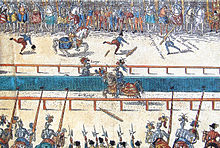Gabriel de Lorges, Count of Montgomery
Gabriel de Lorges | |
|---|---|
| Count of Place de Grève, Paris , France | |
| Spouse(s) |
Isabeau de La Touche
(m. 1550) |
Gabriel de Lorges, Count of Montgomery, Lord of Lorges and Ducey (5 May 1530 – 26 June 1574), was a French nobleman of Scottish extraction and captain of the
Career
On 30 June 1559, during a jousting match to celebrate the

During the First War (1562-63) he fought for the Huguenots, capturing Bourges and leading several campaigns in his native Normandy. He led the defense of Rouen, and escaped the city just as it fell to the enemy.
He remained in France after the Peace of Amboise brought an end to the fighting. He took up arms again in 1567 when the wars of religion were renewed, and served under Condé in the major campaigns of 1567, 1568, and 1569.
Shortly after Condé's death at Jarnac in March 1569, Montgomery was tasked with restoring Jeanne d'Albret, the Huguenot queen of Navarre, to her territories in Béarn, which had been conquered by Catholic forces. He led a rapid campaign, which resulted in the destruction of a Catholic army at Orthez in August 1569.
Montgomery then, in early January, linked up with the survivors of the disastrous battle of Moncontour. The combined army, led by Coligny and the young princes of Condé and Navarre, fought the Catholics to a standstill at Arnay-le-Duc and imposed a favorable peace on the Crown.
He was one of the few leaders to survive the

Montgomery returned to France with a fleet in an attempt to relieve the
A freely adapted version of Montgomery's life is told in
Marriage and issue
He married (1550) Isabeau de La Touche (died 1593), by whom he had four sons and four daughters:
Sons
- Jacques I de Montgomery (1551–1560)
- Gédéon de Montgomery (died 1596)
- Gilles de Montgomery (1558–1596)
- Gabriel II de Montgomery (1565–1635), who built the Château de Ducey, and was father to six children:
- Louise de Montgomery
- Gabriel III de Montgomery (1595–1635)
- Suzanne de Montgomery
- Louis I de Montgomery (1601–1682)
- Jean de Montgomery (1605–1694)
- Jacques III de Montgomery (1609–1682)
Daughters
- Suzanne de Montgomery
- Elisabeth de Montgomery
- Claude de Montgomery
- Roberte de Montgomery, wife of Gawen Champernowne (died 1591) of Dartington in Devon, by whom she had issue. In 1582 she divorced him for adultery and in 1595 married Thomas Horner of Cloford.[3]
Notes
- ^ a b c d e f g Chisholm, Hugh, ed. (1911). . Encyclopædia Britannica. Vol. 18 (11th ed.). Cambridge University Press. p. 783.
- New International Encyclopedia(1st ed.). New York: Dodd, Mead.
- ^ Vivian, Lt.Col. J. L., (Ed.) The Visitations of the County of Devon: Comprising the Heralds' Visitations of 1531, 1564 & 1620, Exeter, 1895, p. 163, pedigree of Champernowne
References
- Landurant, Alain (1988). Montgommery le régicide. Paris: Tallandier. ISBN 2-235-01773-8.
- ISBN 0-87169-161-2.
